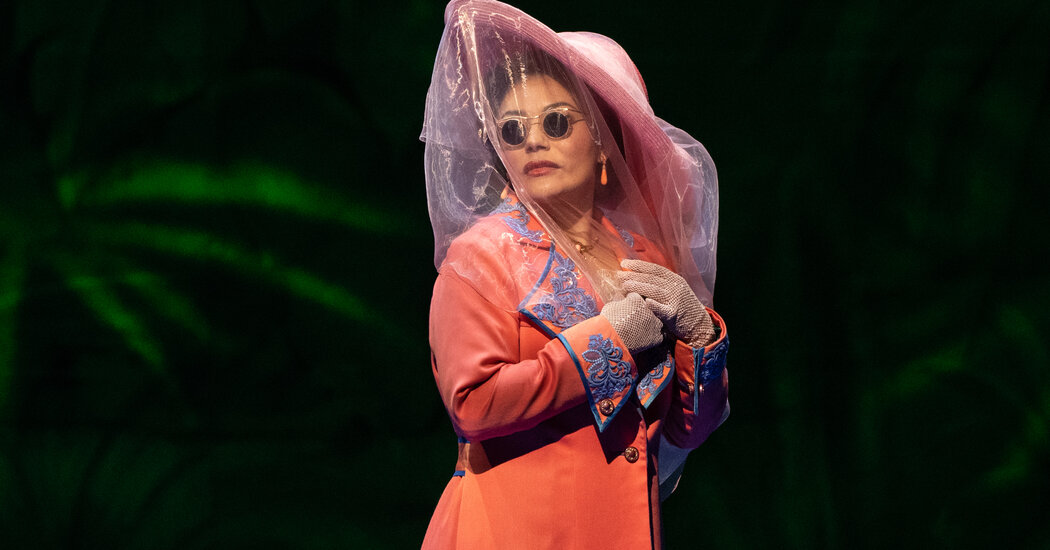Yannick Nézet-Séguin, the Metropolitan Opera’s music director, had stepped onto the podium on Thursday evening to begin the performance. The theater was hushed before his downbeat when a voice rang out from a balcony.
“Viva la ópera en español!” someone shouted, and the audience erupted in applause.
This is what is most notable about the company premiere of Daniel Catán’s heavily perfumed “Florencia en el Amazonas,” starring Ailyn Pérez: It brings a language spoken at home by about a quarter of New York City back to the Met.
Just the third work in Spanish to be presented by the company, “Florencia” is the first in nearly a century, the first full-length and the first to have been written by a composer from Latin America. Born in Mexico in 1949, Catán studied with the serialist master Milton Babbitt, then proceeded to write lush, tonal music that couldn’t be more different from his teacher’s.
Before his death in 2011, Catán specialized in appealingly colorful, politely dull works that harkened back to a much earlier era — one that ended with the posthumous premiere of the final work by his operas’ guiding spirit, Giacomo Puccini, in 1926.
That happens to be the year the Met last put on a Spanish-language opera, and there’s something amusing in the fact that next to nothing in “Florencia,” which premiered in Houston in 1996, would have surprised an audience back then. You almost want to applaud the impressive, if perverse, achievement of a score that so thoroughly rejects all the galvanic musical developments since the early 1900s, when the opera is set.
The action — hardly complex, but crowded — takes place aboard a steamboat in the Amazon rainforest. The passengers are on their way to hear the great diva Florencia Grimaldi sing at the Belle Époque opera house in Manaus, Brazil.
There’s a swooning pair of young lovers, and a bickering married couple; a would-be Grimaldi biographer and a mystical narrator; oh, and Florencia, too, somehow unrecognized by everyone else and returning to Manaus in search of her lover, a butterfly hunter she lost long ago.
Marcela Fuentes-Berain, the work’s librettist, was a student of Gabriel García Márquez, and while the opera is not based directly on any of his books, its debt to his dreamlike magical realism — a style that has dominated outside perspectives on Latin American culture to the point of cliché — is clear.
The characters emote with the rich, sticky languor of a lava lamp, and none come to life with the force of those in the works to which Catán nods. This is an opera that is, first and foremost, a tribute to opera. If your main character is a famous singer, Puccini’s “Tosca” is an inescapable comparison, and Florencia’s last name is the same as the lead soprano role’s in Verdi’s “Simon Boccanegra.”
A recurring, darkly watery tremor motif is borrowed from the music of the phantoms in Puccini’s “Turandot”; in a brief orchestral interlude, a delicate chord that builds from the bottom to the top of the strings is snipped from the opening of Act III of his “La Bohème.”
Played with smooth polish at the Met under Nézet-Séguin, Catán’s score endlessly undulates and glitters, in case we’ve forgotten that we’re on a river. Mellow combinations of winds blend with sumptuous strings, accented discreetly with brasses for an overall glow. Both composer and conductor are sensitive to singers, not smothering their vocal lines but supporting them.
Those lines are effusively lyrical enough to make “Dead Man Walking,” the extremely accessible 2000 opera that opened the Met’s season, seem like nails on a chalkboard by comparison. It’s not that there’s anything inherently wrong with nostalgia. But “Florencia” feels encased in amber, a dead tradition walking.
The piece exudes homogeneous, interchangeable, anesthetized prettiness; you get the sense that any character’s music could have just as easily been transferred to anyone else. While it’s not an unpleasant way to spend a couple of hours, there is nothing approaching vivid characterization or compelling drama — the things that mattered to Puccini, that his supreme lyrical gift was serving.
What “Florencia” does have on its side is brevity, hardly the virtue of most of the new and recent operas that have come to the Met. “Dead Man Walking” sags under two and a half hours of music — the same as “Grounded,” which will open the company’s season next year. Forty-five minutes shorter, “Florencia” is even more slender than its Puccinian models.
Mary Zimmerman’s pared-down yet busy, inelegant production suggests locations on board the ship with a few movable pieces, like railings and deck chairs. Riccardo Hernández’s set surrounds the playing space with curving walls flooded with verdant projections to give a sense of the walls of forest flanking the river.
Puppets and sprightly dancers frolicking in fish and bird headdresses — Ana Kuzmanić designed the “Lion King”-esque costumes — cutely try to convey the region’s exotic explosion of fauna. T.J. Gerckens’s lighting evokes radiant dawns, dusks and nocturnes.
But Zimmerman is at a loss conjuring mystery. The violent storm at the end of the first act is dominated, oddly, by a gentle fall of red confetti. And while the baritone Mattia Olivieri, in his Met debut, sings Riolobo, the narrator, with firm, juicy tone, the staging struggles to capture his status on the blurry boundary between real and magic. The rest of the supporting cast also performs with energy, but Pérez is, appropriately, the uncontested star: wistful, tender and sincere, her voice not enormous but generously delivered, her high notes glistening.
She manages to be both soaring and movingly reserved in Florencia’s closing aria, and the final moments bring a delightful costuming coup, stylishly lit. The score ends not with “Tosca”-style fortississimo, but in muted, modest quiet — a genuinely sweet touch on an often saccharine evening.
Florencia en el Amazonas
Through Dec. 14 at the Metropolitan Opera, Manhattan; metopera.org.
